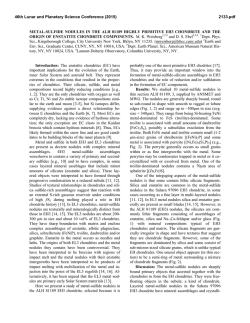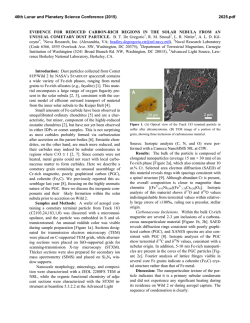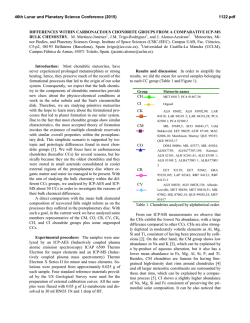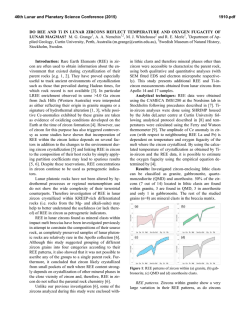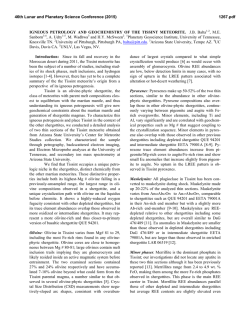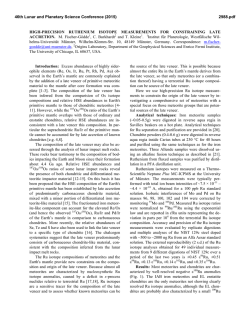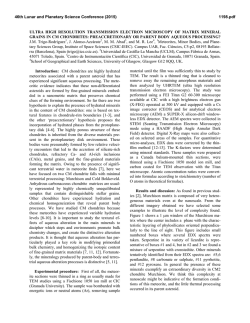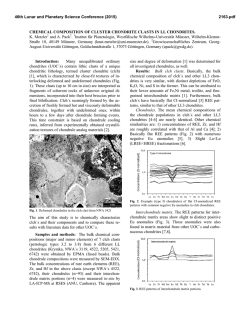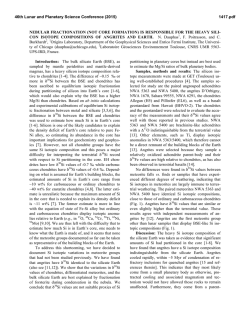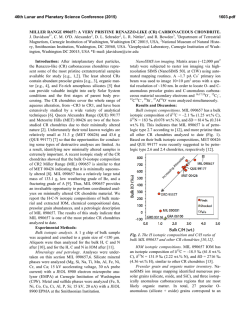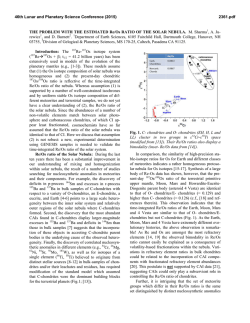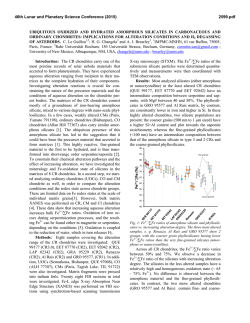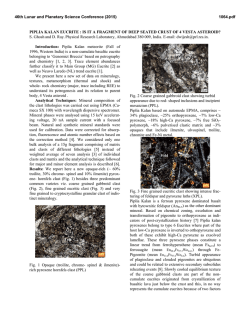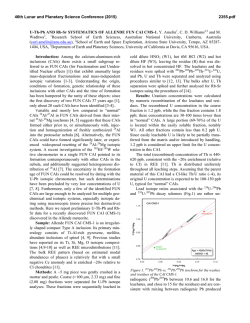
2619
46th Lunar and Planetary Science Conference (2015) 2619.pdf COMPLEMENTARY RARE EARTH ELEMENT ABUNDANCES IN ENSTATITE AND OLDHAMITE IN EH3 CHONDRITES. D. S. Ebel1,2, M. Boyet3, T. Hammouda3, A. Gannoun3, M. K. Weisberg4,2,1, A. El Goresy5. 1 American Museum of Natural History, Central Park West at 79th St., New York, NY 10024 ([email protected]), 2 Earth and Env. Sci., Graduate Center, CUNY, NY, NY 10016, USA,3Laboratoire Magmas et Volcans, Université Blaise Pascal, 5 rue Kessler, 63038 Clermont-Ferrand, 4Dept. Phys. Sci., Kingsborough College, City University New York, Brooklyn, NY 11235, 5Bayerisches Geoinstitut, Universität Bayreuth, 95447 Bayreuth, Germany Introduction: The hypothesis of “complementarity” is important because it offers perhaps the strongest constraint from meteorite cosmochemistry on astrophysical models for chondrule formation and parent body accretion. Complementarity classically is a process that yields the solar bulk composition as the net result of combination in different ratios, of chondrules and matrix of very different compositions [1-3], but also encompasses the net solar abundance by combination of disparate chondrules themselves (e.g., in Fe/Si, [4]), and flat trace elements as the net combination of highly variable CAIs and other components [5]. Complementarity requires that refractory materials (e.g., chondrules) form at high temperature (T), yet coexist with heat-sensitive (matrix, organics, presolar grains, amorphous grains, sulfides) materials, in regions of bulk solar refractory element composition, that then accrete to form parent bodies on timescales shorter than mixing timescales, thus preserving the bulk chondritic (solar) refractory element abundances which are the first order chemical observation by analysts of chondrite meteorites. Such “complementarity” of components in chondrites rules out many hypotheses of chondrule formation (e.g., impact melting, near-sun chondrule formation with efficient large-scale mixing, FSM) [2]. The rare earth elements (REE) are heterogeneously distributed in the least equilibrated EH enstatite chondrites. Larimer and Ganapathy [6] noted using INAA on separates that oldhamite (CaS) has almost all the light REE (LREE) and 30-50% of the heavy REE (HREE). Ebihara [7] stepwise dissolved Yamato 691, finding that acid soluble CaS and MgS have 85% of the LREE and 70% of the HREE, with the remainder in acid-resistant phases (primarily enstatite ~MgSiO3). Crozaz and Lundberg [8] confirmed the relative enrichment of LREE in CaS, and negative Yb anomalies in enstatite. More recently, Gannoun et al. [9] performed modal phase abundance, bulk REE abundance, and comprehensive SIMS and LA-ICPMS analyses of oldhamites. They reported sparse analyses of enstatite [9], and [10] report further work on enstatite, all in the unequilibrated EH3 chondrites Sahara 97072 and 97096 and perhaps the least equilibrated EH3, ALHA 77295. These data sets allow assessment of the relative budgets of REE among the rare oldhamite CaS (~1 vol. %) and enstatite (~60 vol%). Here, we note that the REE budget in the EH3 chondrites supports the notion of the complementary accretion of rare oldhamite with abundant enstatite, both formed from a single reservoir of bulk solar composition, to form bulk rocks nearly perfectly chondritic in REE. Similar relationships of the most refractory components (but not graphite) are inferred for EL3 chondrites [11]. Spatially disparate formation of oldhamite-bearing and enstatite-bearing components, followed by their random mixing to produce flat bulk EH3 patterns, does not seem likely to produce such a flat bulk pattern. It appears rather more likely that both components formed from a bulk solar composition gas + dust mixture, and accreted locally on timescales shorter than large scale mixing timescales, to form the EH3 parent body or bodies. Data: Here, we place more emphasis on data from ALHA 77295, which [9] note is one of the most primitive EH3 chondrites. Others [9, 10] have made strong cases that these EH3 show minimal terrestrial weathering, and that the mineral and bulk REE are unaffected. In this and other EH3 chondrites, the bulk rock REE patterns are flat (Fig. 1), well within 10% of chondritic [9, 10]. 1.2 1.1 1.0 0.9 0.8 0.7 0.6 ALHA77295-G11 Sah 97096-B14 Sah 97158a-B14 La Ce Pr Nd ALHA77295-B14 Sah 97072-G11 sah 97158b-B14 Sah 97096-G11 Sah 97158-G11 Sm Eu Gd Tb Dy Ho Er Tm Yb Lu Fig. 1: REE in whole rock EH3 chondrites. Data from G11(Gannoun et al. 2011 [9]), and B14 (Barrat et al. 2014 [12]), illustrating in particular the extremely chondritic whole rock REE compositions of ALHA 77295 and Sahara 97072. As illustrated in Fig. 2, the oldhamite (CaS, 0.64 vol. % in ALHA 77295 and 1.12% in Sahara 97972 [9]) is enriched in LREE relative to HREE, and strongly enriched in Eu and Yb. Oldhamite patterns are primarily 50-80xCI in LREE, and 20-60xCI in HREE. 46th Lunar and Planetary Science Conference (2015) Fig. 2 includes only the dominant oldhamite type by REE pattern, but all exhibit strong Eu and Yb enrichments [9]. The data for enstatite (57.8 vol. % in ALHA 77295 and 60.3% in Sahara 97072) are less abundant, but indicate 0.5-2xCI with slight enrichment in HREE, and strong negative anomalies in Eu and Yb. Thus the enstatites are to first order complementary to the oldhamites in REE. Niningerite does not play a significant role in the REE budget, since its REE concentrations are comparable to enstatite’s, but its modal abundance is < 2 vol%. Fig. 2: Replication of Figures 5 and 7 of Gannoun et al. (2011, [4]), illustrating dominant enstatite and oldhamite REE compositions of ALHA 77295 and Sahara 97072. Fig. 3: Adaptation of Figure 8c of Gannoun et al. (2011, [9]), illustrating disparate contributions of oldhamite and enstatite to the (flat) whole rock REE budget of the EH3 chondrites ALHA 77295 and Sahara 97072. One critical observation in the data is the strong trend between LREE and HREE. Although there is 2619.pdf some spread in the enstatite data, the majority of oldhamites show extreme positive anomalies in Eu and Yb. These anomalies are exactly compensated for by distinct depletions in Eu and Yb in the far more abundant enstatite. Why should this be so? Discussion: These data are sufficient to establish a complementary relationship between the primary mineral carriers of REE in EH chondrites. Such a relationship implies similar origins of enstatite and oldhamite from a single reservoir of material of solar bulk composition, in proximal time and space in the primitive nebula, and accretion of both into an EH parent body on a timescale short relative to that of mixing with other REE carriers. REE variations in both CaS and enstatite likely reflects decreasing temperature during equilibration of both phases with vapor. Earlier CaS would be enriched in REE, later would be depleted. The apparently “complex histories” of oldhamites, as discussed by [9], may simply be due to highly local variations in oxygen fugacity and/or temperature in a dynamic system. Conclusion: The data of [9] and [10, pers. comm.] allow a strong interpretation of complementarity between the most REE-rich phases in EH3 chondrites: enstatite and oldhamite. In EH3, enstatite (~60 vol%) and oldhamite (~1 vol%), carry REE at concentrations ~1xCI and ~80xCI, respectively. Most importantly, oldhamite has high Eu and Yb and enstatite the reverse. Mixing of these two minerals in anything but the exactly correct proportions would not yield bulk EH3 flat in the REE. Beyond the complementary relationship of these refractory components, the cosmochemical reasons for the observed anomalies in Eu and Yb remain enigmatic, as they are not predicted by thermodynamic equilibrium at high C/O ratios [13]. Acknowledgments: This research was supported by U.S. N.A.S.A. grants NNX10AI42G (DSE), NNX12AI06G (MKW), and ERC funding under the European Community’s Seventh Framework Programme (FP7/2007-2013 Grant Agreement no. 209035). This research has made use of NASA's Astrophysics Data System Bibliographic Services. ALHH 77295 was supplied by ANSMET through the Meteorite Working Group. References: [1] Bland et al. (2005) PNAS, 102, 1375513760. [2] Hezel D.C. & Palme H. (2010) EPSL, 294, 85-93. [3] Palme H., Hezel D.C., Ebel D.S. (2015) EPSL, in press [4] Ebel et al. Meteor. Planet. Sci., 43, 1725-1740. [5] Crapster-Pregont E.J. & Ebel D.S. (2014) LPS XLV, Abstract #1379. [6] Larimer & Ganapathy (1987) GCA, 84, 123-134. [7] Ebihara M. (1988) NIPR Symp. Antarctic Mets. 1, 102112. [8] Crozaz G. and Lundberg L.L. (1995) GCA, 59, 3817-3831. [9] Gannoun A. et al. (2011) GCA, 75, 32693289. [10] Hammouda et al. (2013) Mineral. Mag., 77, 1250. [11] El Goresy et al. (2012) Meteor. Planet Sci. 47, A125 (#5108). [12] Barrat J.A. et al. (2014) GCA 128, 71-94. [13] Lodders K. & Fegley B. (1993) EPSL, 117, 125-145.
© Copyright 2025

